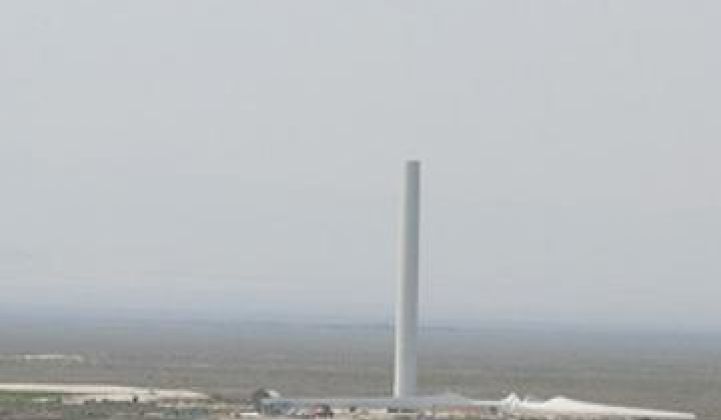Some 292,000 megawatt-hours of wind power were curtailed by the Midwest transmission system operator in 2009; in 2010, that figure jumped to about 824,000 megawatt-hours. At a rule-of-thumb 7 cents per kilowatt-hour, that makes the rough cost for one system’s 2010 generation capacity losses $37,240,000 more (at $57,680,000) than losses in 2009 ($20,440,000).
Even in energy generation, those are big numbers -- but the rate at which they have increased is even more intimidating to a wind industry struggling to keep costs competitive.
“Curtailment,” Gary Moland, Director of Market Analysis with GL Garrard Hassan, explained, “is reducing generation at a facility below what it could be capable of producing.”
“For most generation facilities,” Moland said, “if you stop putting power out, you also stop consuming the fuel so the consequences of being curtailed are sort of offset.” If, however, “you are not able to take advantage of the wind blowing, that wind is gone.” Moland went on, saying this practice “has a bigger impact on the economics of the plant.”
“Capacity factor measures the power output from a generator as a percentage of its maximum capability. With most forms of generation, you would operate at whatever capacity factor is economic,” Moland said. “With wind, it is dictated by however much wind is blowing.”
The best wind sites have about a 40 percent capacity factor, meaning they produce an average of 40 megawatts per 100 megawatts of nameplate capacity over “all the hours of a year.”
“If you’re losing -- curtailing -- two percent of that generation,” Moland said, “it really has a big impact.” Capacity factor is reduced to 38 percent, perhaps five percent of a wind farm’s production. “All the cost of a wind plant is upfront,” Moland explained. “All the financial models looking at rate of return on investment assume a certain level of wind availability.”
In Texas, where transmission congestion is a significant problem because wind development has been big and fast, “It’s not unheard of for wind to be curtailed between ten and twenty percent,” Moland said. “You’re moving from 40 percent capacity factor down to 32. That’s twenty percent of your output.” It is a serious hit. “Your revenue stream is less and your return on investment is lower.” At a time when wind is locked in an urgent fight with natural gas for market share, curtailment could be the make-or-break issue.
Where wind is curtailed, it can ruin a plant’s profitability. Where it is anticipated by forward-looking models such as the ones Moland uses to perform congestion studies at GL Garrard Hassan and those used by transmission planners, it can make a viable development non-viable.
Far and away the primary cause of curtailment is limited transmission, Moland said. There has in recent years been large-scale rapid development in the wind-rich Midwestern regions of the U.S. from the Canadian border to Texas, “where you get that 40 percent wind availability.” Transmission development has not kept pace.
“You can go from starting construction to delivering power at a wind site in twelve months, or even less, whereas building a transmission line to service a new site,” Moland said, “usually takes three to five years.”
Initial development usually does not burden existing lines, he explained, “but once you get over a certain level, transmission lines become congested during high wind hours and the only solution to not overloading those lines is to reduce the amount of electricity coming out of the wind turbines.”
Moland mentioned other factors that could idle turbines, including (1) an operator’s requirement for instantly available spinning reserves, (2) scheduled or unscheduled turbine maintenance or (3) extreme weather conditions. However, none of these come near to being as significant as the nationwide impact on wind’s economics due to inadequate and congested transmission.
“Lenders who finance plant development expect a certain return,” Moland said. If “that plant under-performs, it impacts both the return economics and their appetite to finance additional plants,” Moland said.
Most lenders now require congestion curtailment studies, which assimilate a wide range of curtailment risk factors. “Along with how good the wind is and the potential markets to sell the wind, transmission is now a piece of the analysis,” Moland said. “If transmission limitations are identified, it’s going to make it an extra hurdle in getting the site financed.”
One additional -- and particularly crucial -- way that curtailment impacts wind economics is through utility power purchase agreements (PPAs).
Utilities motivated to add wind to their portfolios, either because of state mandates or because they anticipate that such assets will accrue in value, now may find it necessary either to require developers to accept a certain level of unreimbursed curtailment or to commit to paying even if production is curtailed. Often, it is only by insulating developers from curtailment losses that utilities can meet planned or mandated goals.
“The utility has some mechanisms in the market to hedge congestion risk,” Moland said. But what the utility cannot hedge may, of course, be passed along to the ratepayer.
The best solution for eliminating curtailment, Moland speculated, would be cost-effective energy storage. But the three best candidates (pumped hydro, compressed air and battery storage) presently have challenges that limit their cost-effectiveness.
New transmission is the ultimate answer. It requires an infrastructure investment but, Moland pointed out, studies such as the 2008 Joint Coordinated System Plan from eastern U.S. system operators suggest that spending to build transmission saves costs, such as those of curtailment, in the long run.



